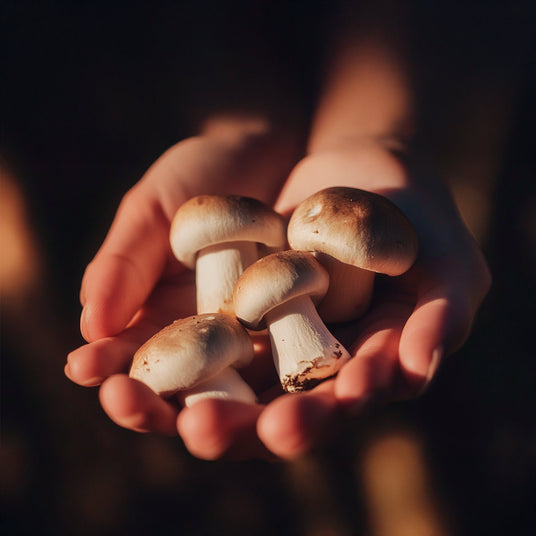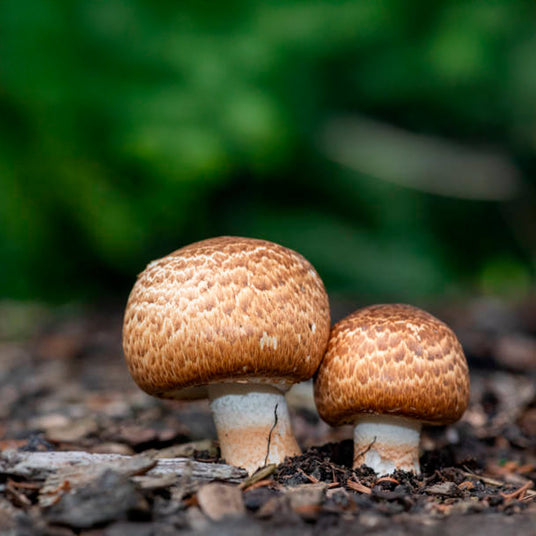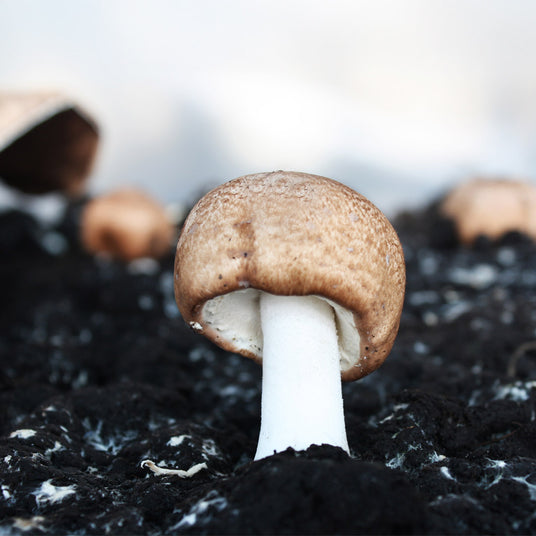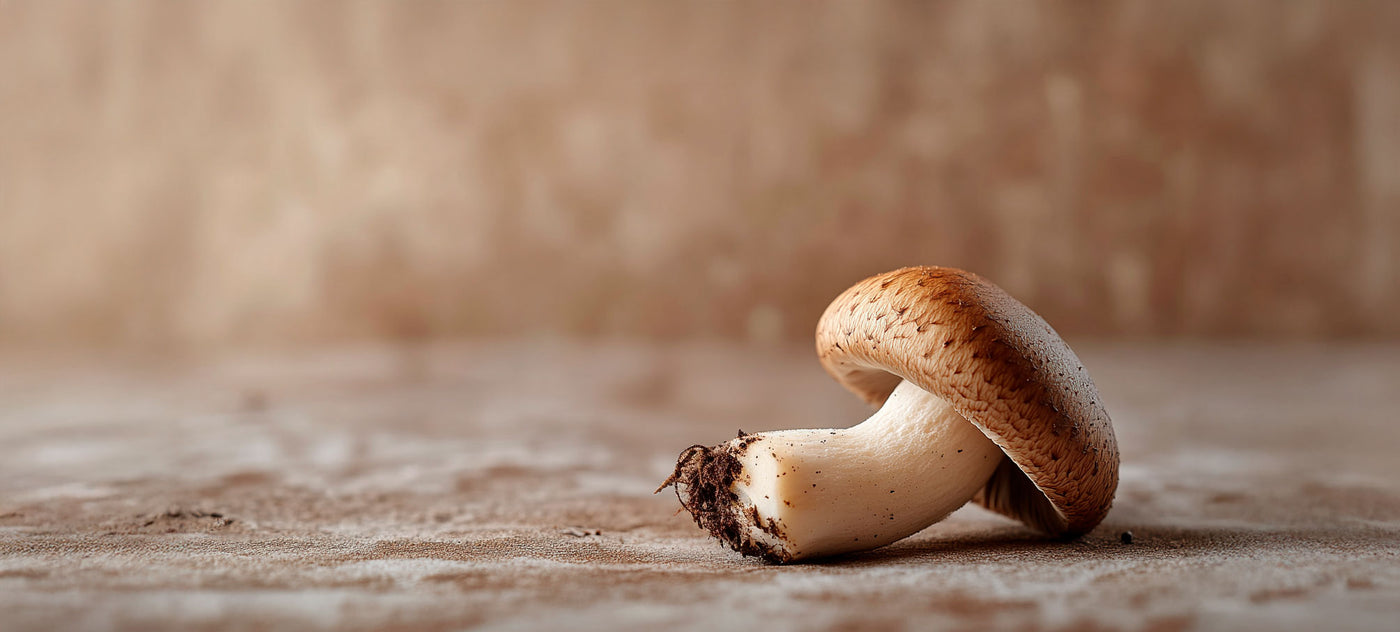
ESSENTIAL NOTES ON ‘GREAT MUSHROOM OF THE SUN’
Agaricus blazei Murill stands out for its high content of active biomolecules, especially β-glucans (modulating polysaccharides) and minerals such as zinc. These and other biomolecules make the sun mushroom the subject of ongoing scientific research. Consumption in Brazil The most striking fact related to the discovery of this mushroom in the mountainous regions of the southern Atlantic Forest in the state of São Paulo (Brazil) is reported in a 2008 scientific article published in the Scandinavian Journal of Immunology.ncbi.nlm.nih.gov/18782264/">a scientific article published in 2008 in the Scandinavian Journal of Immunology. This link led numerous researchers to focus on studying its composition, observing relevant substances. As a result of this initial research, there was an increase in the consumption of this fungus worldwide, with the consequent expansion of its cultivation and further scientific work to investigate its behaviour as a nutraceutical.

DOCUMENTED USES OF THE SUN MUSHROOM
Like species such as Reishi or lion's mane, the sun mushroom has been introduced into the human diet for its properties. The Sun Mushroom can be eaten like Paris mushrooms or chanterelles and included in the diet. This species has white flesh and is slightly fibrous. In cooking, it stands out for its almond aroma and flavour, which is why it is also referred to as “almond mushroom”.
High concentrations of active biomolecules
However, this is not the preferred method of consumption for obtaining high concentrations of its active biomolecules. The extract is the most concentrated form in which the active biomolecules of the sun mushroom can be found, which can be found in capsules as a single ingredient (Mico-Sol) or combined (Mico-Five). It is also available in liquid form in the infant formula Dr. Immune Five. The extracts can be obtained using sustainable technologies, without denaturing their compounds. The result of this process is a higher concentration of the substances of interest and, therefore, better use of them.
Products with sun mushroom
-
Dr. Immune Five Syrup (Reishi, Agaricus, Oyster, Chaga, Shiitake)
HELP CHILDREN'S IMMUNE SYSTEMS
From £29.00Unit price /Unavailable -
Mico Five (Chaga, Reishi, Maitake, Shiitake, Sun mushroom) Capsules
SUPPORTS IMMUNE RESPONSE*
From £54.00Unit price /Unavailable -
Mico Sol (Agaricus blazei) extract capsules
CONTRIBUTES TO THE ACTIVITY OF THE IMMUNE SYSTEM*
£65.00Unit price /Unavailable

SOL MUSHROOM CULTIVATION
Agaricus blazei, like other species of the Agaricus genus, can be cultivated on decomposing herbaceous substrates or artificial substrates composed of plant debris, animal manure and other mineral substances that are subsequently pasteurised or sterilised. However, if production is geared towards sustainability and ecosystem care, more sophisticated systems with controlled environments, organic substrates, etc. are used.
Do you want to know more?
Habitat and distribution
Habitat and distribution
This fungus lives as saprophyte(It feeds on decomposition organic matter) in wooded areas colonizing the substrate rich in organic soil matter of these forests, where the average temperatures are of the order of the 25 ºC and the rains help create a humid and warm atmosphere. As indispensable conditions it requires Wet and hot environments Typical of the Brazil region from where it proceeds: the temperatures of its native region range between 35 ° C of maximum during the day and a minimum of 22 ºC at night. It also grows in the southeast area of the United States (Florida and Louisiana). Since the 80s, it is located in other regions where it is cultivated using different methods according to its productive purpose. At present, this fungus has acquired great commercial importance, thus extending through various countries in America, Asia and, to a lesser extent, Europe.
Mycological notes
Mycological notes
In 1893 the fungus was first described as Agaricus surfrescens Peck In the United States. In 1947, the American taxonome Dr. Murrill described him again and published it with his name, Agaricus Blazei Murrill. At that time it was already known ‘The almond fungus’ from Brazil (Agaricus brasiliensis), but no connection was made and it was thought that it was three different species. The in -depth studies carried out in 2002 by the researchers Wassermann and Didukh and the analysis of the genome sequence by researcher Kerrigan showed that it is the same fungus. Although the oldest name used scientifically is Agaricus surfrescensPeck, the use of Agaricus Blazei Murrill. Interestingly, the cultivation of the Brazilian fungus was initiated by a Japanese myths that resided in Brazil, which explains that this fungus was grown in many Asian countries since the 1980s. Agaricus Blazei It has a carpophore about 12 cm in diameter, with a brown-gold cuticle, convex form and fleshy consistency. The sheets are dark brown.
The culture in bioreactors
The culture in bioreactors
Maximum quality, purity and power in our production systems
One of the Hifas Research Lines Da Terra more powerful focuses on the continuous improvement of Cultivation of different species in bioreactors (Reishi, Lion's Mane, Shiitake and Maitake) using certified ecological substrates, as well as in the standardization of the quality of origin ingredients to guarantee the Excellence in the final product That develops with each fungus.
Hifas Quality System
Through a standard of its own quality, We identify biomolecules and active ingredients, We properly select the strains of fungi that contain them, we use own and specific analytical systems and we apply protocols for Analysis in different production phases. Thanks to this rigorous system we offer natural products, supplements and nutraceutics, with HIFAS QUALITY SYSTEM , making the difference with respect to other products in terms of purity and premium quality.
R&D and Sun Mushroom Studies
R&D and Sun Mushroom Studies
- Hifas Da Terra conducts studies to improve fungus production processes and optimize the development of new biotechnological base ingredients
- Hifas da Terra has, in its wide mycoteca (Micological Bank Hifas), its own strains isolated from the Iberian Peninsula that selects for the development of its formulas
- Hifas da Terra develops multiple studies in collaboration with research centers and universities.
Curiosities
Curiosities
- Sun mushroom, unlike other species that prefer semi -shade, can grow directly to the sun.






















